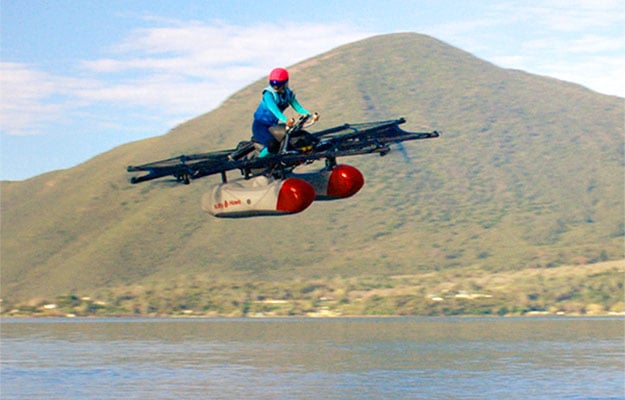Larry Page’s ‘Kitty Hawk’ Flying Car Project Takes To The Skies
Flying cars are no longer just a fantasy from The Jetson’s. Kitty Hawk, a Silicon Valley company backed by Google founder Larry Page, recently tested its Kitty Hawk flyer.
The Kitty Hawk Flyer is an ultralight electric aircraft that is currently FAA approved, and has been categorized as an aircraft that does not require a pilot’s license. The aircraft is intended for recreational purposes over open water. The vehicle cannot be flown over land or in urban areas.

The aircraft has been designed by several Silicon Valley leaders and entrepreneurs. Its chief executive is Sebastian Thrun, who founded Google’s X Lab. Thrun also brought on Cameron Robertson and Todd Reichert, aerospace engineers originally from AeroVelo. Robertson and Reichert are best known for their human-powered helicopter and their bicycle land speed records.
The company is currently testing the Flyer over open water in order to avoid any serious accidents. The aircraft was recently seen being tested over Clear Lake in California. An aerospace engineer controlled the vehicle with two joystick-like controls and flew the vehicle roughly fifteen feet above the water.
There is little known about the Flyer’s specifications or price, however, Kitty Hawk promises that the finished project will look different and be quieter than the prototype. It appears that the company is hoping that the potential of the project will interest future customer and investors. It is currently promoting a three-year membership for $100 USD. Members will receive priority placement on the product waitlist and $2,000 off their purchase, access to flight simulators, demonstrations, and events where they will be able to test the Flyer, behind-the-scenes videos and updates, and exclusive Kitty Hawk gear.
The Kitty Hawk Flyer will go on sale by the end of 2017, while specifications and pricing will be revealed closer to the release date. Only time will tell if Kitty Hawk will be able to live up to their mission of making “the dream of personal flight a reality”.
The Kitty Hawk Flyer is an ultralight electric aircraft that is currently FAA approved, and has been categorized as an aircraft that does not require a pilot’s license. The aircraft is intended for recreational purposes over open water. The vehicle cannot be flown over land or in urban areas.

The aircraft has been designed by several Silicon Valley leaders and entrepreneurs. Its chief executive is Sebastian Thrun, who founded Google’s X Lab. Thrun also brought on Cameron Robertson and Todd Reichert, aerospace engineers originally from AeroVelo. Robertson and Reichert are best known for their human-powered helicopter and their bicycle land speed records.
The company is currently testing the Flyer over open water in order to avoid any serious accidents. The aircraft was recently seen being tested over Clear Lake in California. An aerospace engineer controlled the vehicle with two joystick-like controls and flew the vehicle roughly fifteen feet above the water.
There is little known about the Flyer’s specifications or price, however, Kitty Hawk promises that the finished project will look different and be quieter than the prototype. It appears that the company is hoping that the potential of the project will interest future customer and investors. It is currently promoting a three-year membership for $100 USD. Members will receive priority placement on the product waitlist and $2,000 off their purchase, access to flight simulators, demonstrations, and events where they will be able to test the Flyer, behind-the-scenes videos and updates, and exclusive Kitty Hawk gear.
The Kitty Hawk Flyer will go on sale by the end of 2017, while specifications and pricing will be revealed closer to the release date. Only time will tell if Kitty Hawk will be able to live up to their mission of making “the dream of personal flight a reality”.

